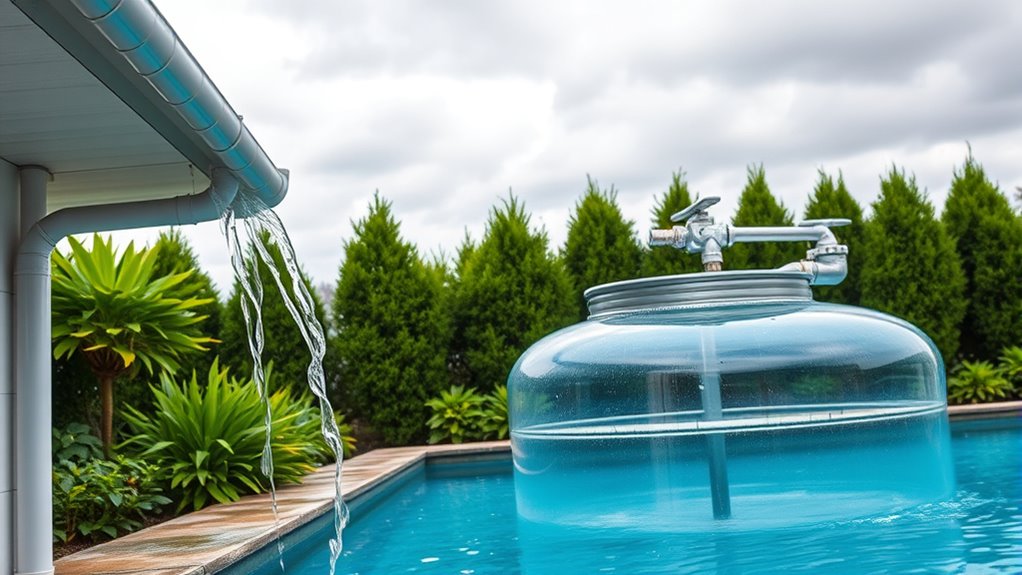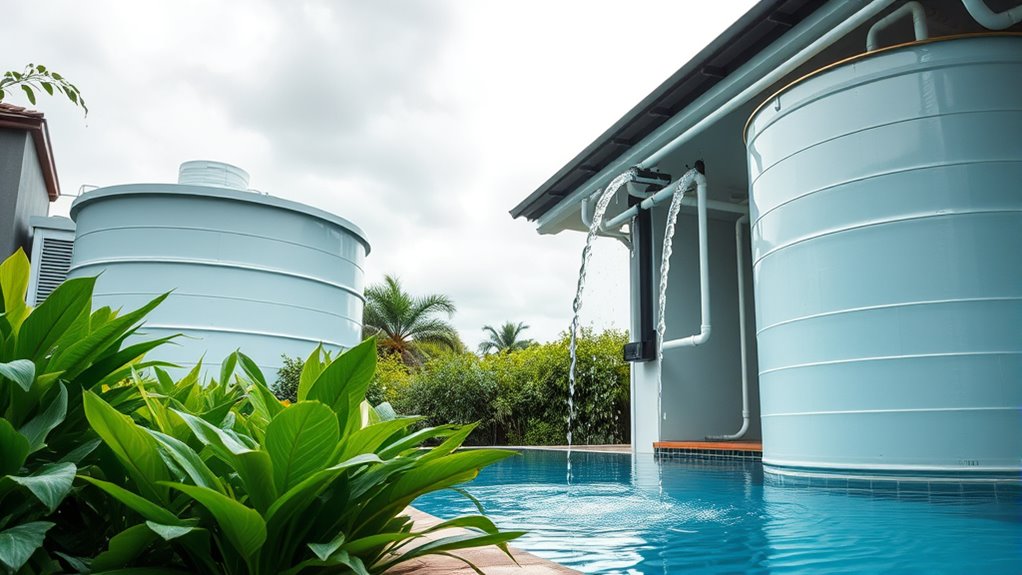Implementing rainwater harvesting systems for your pool is an eco-friendly and cost-effective way to keep your water levels topped up. You can collect rainwater through gutters equipped with filters and first-flush diverters, then store it in tanks designed to prevent algae growth and contamination. Proper maintenance and integration with your pool’s circulation system guarantee clean, reliable water supply. Keep exploring to discover more tips on optimizing your rainwater harvesting setup for your pool.
Key Takeaways
- Install gutter guards and leaf screens to collect clean rainwater for pool replenishment.
- Use appropriately sized, non-toxic storage tanks with secure lids to store harvested rainwater.
- Incorporate multi-stage filtration systems to remove debris and contaminants before water enters the pool.
- Connect the filtration and storage system seamlessly to the pool’s circulation for continuous replenishment.
- Regularly maintain filters and tanks to ensure water quality and system efficiency for safe swimming.

Rainwater harvesting systems offer an eco-friendly and cost-effective way to replenish your pool’s water level. By capturing rainwater, you reduce your reliance on municipal water sources and lower your utility bills. To make this work efficiently, you need to focus on proper rainwater filtration and storage tank design. These components are crucial for ensuring the water you collect is clean, safe, and suitable for pool use.
Rainwater filtration is the first step in creating an effective harvesting system. When rainwater falls, it picks up debris, leaves, dirt, and sometimes pollutants from the roof or collection area. Installing a good filtration system prevents these contaminants from entering your storage tank. You might use leaf screens or gutter guards at the collection point to block large debris, followed by finer filters or first-flush diverters that remove smaller particles and prevent contaminated water from reaching your tank. This process ensures that the water you collect is cleaner, reducing the need for chemical treatment later and protecting your pool equipment from clogging or damage.
Use leaf screens and filters to keep rainwater clean before it reaches your tank.
Next, pay close attention to your storage tank design. The tank should be made of durable, non-toxic materials that resist algae growth and prevent contamination. Position it in a shaded or cool location to slow algae development and keep the water fresher longer. The tank’s size matters, too; it should be large enough to hold sufficient water during rainy periods, but not so big that it becomes difficult to manage or maintain. Consider installing a secure lid to keep out pests and debris and an outlet that allows easy connection to your pool’s water circulation system. A well-designed tank will also include features like overflow outlets to manage excess water during heavy rains and a tap or valve for convenient water extraction.
Integrating rainwater filtration and thoughtful storage tank design means you’ll have a reliable, sustainable source of water for your pool. It’s essential to regularly inspect and clean your filters and tank to maintain top performance. Using a combination of quality filters, properly designed tanks, and strategic placement, you can maximize the benefits of rainwater harvesting. Additionally, understanding water quality considerations such as potential pollutants and filtration needs helps ensure the water remains safe for swimming and does not harm your pool equipment. This not only supports environmental conservation but also ensures your pool remains adequately filled, especially during dry seasons or droughts. With these considerations, you’ll create a system that is both efficient and easy to maintain, saving you money and reducing your ecological footprint over time.
Frequently Asked Questions
What Is the Cost Comparison Between Rainwater Harvesting and Municipal Water?
You’ll find that rainwater harvesting generally costs less than municipal water, thanks to lower ongoing expenses. A cost analysis shows that, while initial setup can be higher, the savings on water pricing over time make it more economical. Municipal water prices tend to rise, whereas rainwater systems reduce your reliance on these rates. Overall, investing in rainwater harvesting offers a cost-effective solution for pool replenishment and other needs.
How Do I Maintain and Clean My Rainwater Harvesting System Effectively?
A stitch in time saves nine, so stay ahead of dirt. Regularly check and replace your filtration methods, like mesh or cartridge filters, to keep water clean. Remove sediment buildup from the collection surface and downspouts using a broom or hose. Clean your storage tank periodically with a brush and disinfectant. Consistent maintenance guarantees your system functions efficiently, just like a well-oiled machine, and keeps your pool water pristine.
Are There Legal Restrictions on Rainwater Harvesting in My Area?
You should check your local laws to see if there are legal restrictions on rainwater harvesting. Some areas have water rights or regulations that limit or require permits for collecting rainwater. Contact your municipality or water authority to understand specific rules. Ignoring these restrictions could lead to fines or legal issues. Staying informed helps you comply with regulations and ensures your rainwater harvesting system operates legally and effectively.
Can Rainwater Harvesting Systems Be Integrated With Existing Pool Equipment?
Think of your pool system as a well-oiled machine ready for an upgrade. Yes, you can integrate rainwater harvesting systems with your existing pool equipment. Just guarantee proper rainwater filtration to keep debris out, and connect the harvesting setup seamlessly with your pool’s plumbing. This integration can help save water and reduce costs, making your pool maintenance smoother and more eco-friendly, like giving your pool a fresh breath of nature.
What Are the Best Practices for Ensuring Water Quality in Harvested Rainwater?
To guarantee water quality in harvested rainwater, you should implement effective water filtration systems to remove debris and contaminants. Regularly inspect and clean your collection and storage components to prevent contamination. Use first-flush diverters to discard initial runoff, which often contains pollutants. Adding appropriate disinfectants can help prevent microbial growth. Consistently monitoring water quality and maintaining your system will keep your harvested rainwater safe for pool replenishment.
Conclusion
By now, you see how rainwater harvesting systems can effortlessly keep your pool filled and save you money. Isn’t it smart to turn a natural resource into a sustainable solution? With simple setup and maintenance, you can enjoy a cleaner, eco-friendly pool year-round. Why not embrace this smart, cost-effective method to enhance your pool experience? Start harvesting rainwater today and make a positive impact on both your wallet and the environment.









